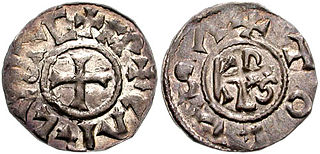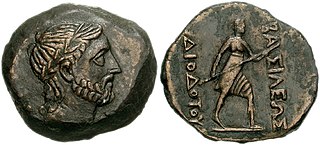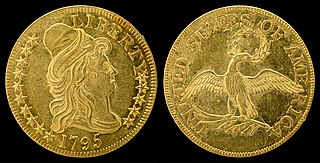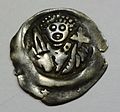
Roman currency for most of Roman history consisted of gold, silver, bronze, orichalcum and copper coinage. From its introduction to the Republic, during the third century BC, well into Imperial times, Roman currency saw many changes in form, denomination, and composition. A persistent feature was the inflationary debasement and replacement of coins over the centuries. Notable examples of this followed the reforms of Diocletian. This trend continued into Byzantine times.

Byzantine currency, money used in the Eastern Roman Empire after the fall of the West, consisted of mainly two types of coins: the gold solidus and a variety of clearly valued bronze coins. By the end of the empire the currency was issued only in silver stavrata and minor copper coins with no gold issue.

The dime, in United States usage, is a ten-cent coin, one tenth of a United States dollar, labeled formally as "one dime". The denomination was first authorized by the Coinage Act of 1792.

The Carolingian monetary system or Carolingian coinage system, often just called a Carolingian system was first created at the end of the 8th century by Emperor Charlemagne to give direction for the minting of coins, influencing coinage in Europe for several centuries and being adopted by many countries worldwide. It is characterised by having three denominations in the ratio 1:20:240, for example, 1 pound consisting of 20 shillings and 240 pence.

The pfennig or penny is a former German coin or note, which was the official currency from the 9th century until the introduction of the euro in 2002. While a valuable coin during the Middle Ages, it lost its value through the years and was the minor coin of the Mark currencies in the German Reich, West and East Germany, and the reunified Germany until the introduction of the euro. Pfennig was also the name of the subunit of the Danzig mark (1922–1923) and the Danzig gulden (1923–1939) in the Free City of Danzig.

Diodotus II Theos was the son and successor of Diodotus I Soter, who rebelled against the Seleucid empire, establishing the Graeco-Bactrian kingdom. Diodotus II probably ruled alongside his father as co-regent, before succeeding him as sole king around 235 BC. He prevented Seleucid efforts to reincorporate Bactria back into the empire, by allying with the Parthians against them. He was murdered around 225 BC by the usurper Euthydemus I, who succeeded him as king.

Groschen a name for various coins, especially a silver coin used in various states of the Holy Roman Empire and other parts of Europe. The word is borrowed from the late Latin description of a tornose, a grossus denarius Turnosus, in English the "thick denarius of Tours". Groschen was frequently abbreviated in old documents to gl, whereby the second letter was not an l, but a abbreviation symbol; later it was written as Gr or g.

The German mark was the currency of the German Empire, which spanned from 1871 to 1918. The mark was paired with the minor unit of the pfennig (₰); 100 pfennigs were equivalent to 1 mark. The mark was on the gold standard from 1871–1914, but like most nations during World War I, the German Empire removed the gold backing in August 1914, and gold and silver coins ceased to circulate.

The Heller, abbreviation hlr, was a coin, originally valued at half a pfennig, that was issued in Switzerland and states of the Holy Roman Empire, surviving in some European countries until the 20th century.
Silver coins are considered the oldest mass-produced form of coinage. Silver has been used as a coinage metal since the times of the Greeks; their silver drachmas were popular trade coins. The ancient Persians used silver coins between 612–330 BC. Before 1797, British pennies were made of silver.

The half eagle is a United States coin that was produced for circulation from 1795 to 1929 and in commemorative and bullion coins since 1983. Composed almost entirely of gold, its face value of five dollars is half that of the eagle coin. Production of the half eagle was authorized by the Coinage Act of 1792, and it was the first gold coin minted by the United States.

Friesach is a historic town in the Sankt Veit an der Glan district of Carinthia, Austria. First mentioned in an 860 deed, it is known as the oldest town in Carinthia.
The Venetian grosso is a silver coin first introduced in Venice in 1193 under doge Enrico Dandolo. It originally weighed 2.18 grams, was composed of 98.5% pure silver, and was valued at 26 dinarii. Its name is from the same root as groschen and the English groat, all deriving ultimately from the denaro grosso.

The use of historical money in Tibet started in ancient times, when Tibet had no coined currency of its own. Bartering was common, gold was a medium of exchange, and shell money and stone beads were used for very small purchases. A few coins from other countries were also occasionally in use.

A farthing was a coin of the Kingdom of England worth one quarter of a penny, 1⁄960 of a pound sterling. Such coins were first minted in England in silver in the 13th century, and continued to be used until the Kingdom of England was merged into the new Kingdom of Great Britain in 1707.
Carthaginian or Punic currency refers to the coins of ancient Carthage, a Phoenician city-state located near present-day Tunis, Tunisia. Between the late fifth century BC and its destruction in 146 BC, Carthage produced a wide range of coinage in gold, electrum, silver, billon, and bronze. The base denomination was the shekel, probably pronounced in Punic. Only a minority of Carthaginian coinage was produced or used in North Africa. Instead, the majority derive from Carthage's holdings in Sardinia and western Sicily.

The history of Saxon coinage or Meissen-Saxon coinage comprises three major periods: the high medieval regional Pfennig period, the late medieval Pfennig period and the Thaler period, which ended with the introduction of the Mark in 1871/72. Rich silver deposits, which were discovered near Freiberg after the middle of the 12th century, helped Saxony to a leading position in German coinage.

The Sachsenpfennig, sometimes called the Wendenpfennig or the Hochrandpfennig was a well-known coin of the pfennig type minted in the eastern part of the Stem Duchy of Saxony during the 10th and 11th centuries. It had an upturned perimeter and, next to the Otto Adelheid Pfennig was the most common pfennig type of its time. Sachsenpfennigs are the oldest coins minted in Saxony. Its different names represent a lack of clarity within mediaeval numismatics about the coin.
A Münzfuß is an historical term, used especially in the Holy Roman Empire, for an official minting or coinage standard that determines how many coins of a given type were to be struck from a specified unit of weight of precious metal. The Münzfuß, or Fuß ("foot") for short in numismatics), determined how much of a precious metal (fineness) a coin would have. Mintmaster Julian Eberhard Volckmar Claus defined the standard in his 1753 work, Kurzgefaßte Anleitung zum Probieren und Münzen, as follows: "The appropriate proportion of metals and the weight of the coin, measured according to their internal and external worth, or determined according to their quality, additives and fineness, number and weight, is called the Münzfuß."

The Otto Adelheid Pfennig (OAP) was a German coin type bearing the names of Emperor Otto III of the Holy Roman Empire and his grandmother Adelaide of Burgundy (Athalhet), which was minted soon after 983 as a regional pfennig in the Harz region. Minting took place at more than one mint in the area between Hildesheim and Quedlinburg and lasted unchanged until the middle of the 11th century.






















